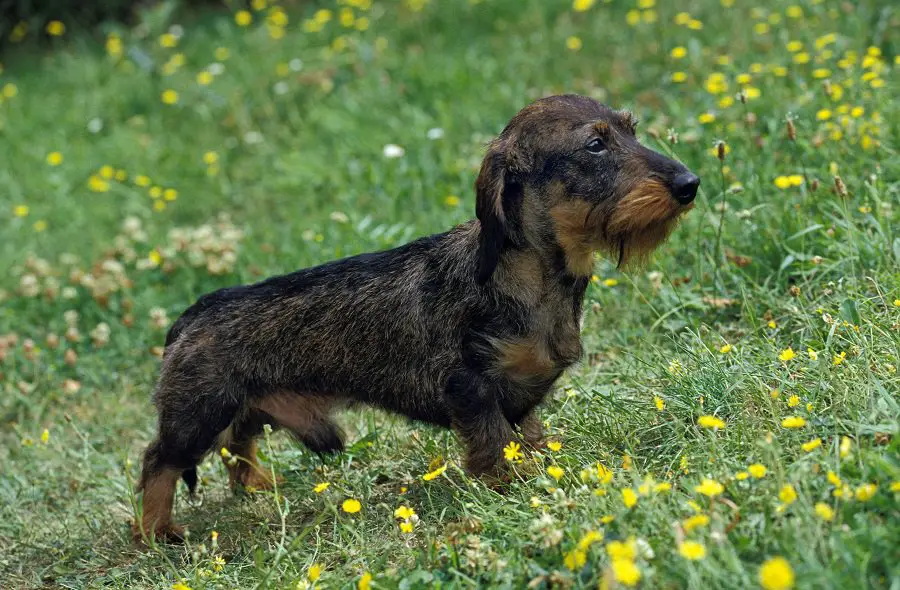Ever come across the term ‘Teckel’ while discussing dogs? Not sure what it means?
Well, if you don’t know what a Teckel is, you are not alone. While the name might seem unfamiliar, this dog breed is more popular than you would think.
Strictly speaking, a Teckel is nothing but a Dachshund. You might be more familiar with Dachshunds being referred to as doxies, sausage hounds, hotdogs, Weiner dogs, weenie dogs, or even Deckels.

All of these names represent a Dachshund. Similarly, Teckel is just another name for this breed.
However, depending on your location, there might be some nuanced differences between a Teckel and a Dachshund.
Curious about these differences? Then let’s dig in!
Where Did the Terms Dachshund and Teckel Come from?

The name ‘Dachshund’ is of German origin and is a combination of two German words – Dachs meaning ‘badger’ and Hund meaning ‘hound or dog’.
Old texts from the early 18th century allude to two terms, Dachs Kriecher meaning ‘badger crawler’ and Dachs Krieger meaning ‘badger warrior’. These probably were initial iterations of the breed’s German name.
The Merriam-Webster dictionary indicates that the term Dachshund was first incorporated in the English language in 1878.
The Dachshund is one of the oldest hunting breeds. Some have theorized that the breed originates back to the ancient Egyptians and that Dachshunds have been in existence for over 4000 years.
It is even said that an old Egyptian monument belonging to one of the pharaohs had an engraving that said “tera”, leading to some people suggesting that the term Teckel could have originated from here. There is, however, little proof of this theory.
The modern version of the Dachshund though has more proof about its origins and can be found in illustrations and texts ranging from the late 15th century to the early 18th century.
Dachshunds are said to be bred originally in Germany as a hunting and tracking dog for small game. Over generations, Dachshunds have especially been bred to be suitable for hunting below ground.
The term Teckel too seems to have its origins in Germany. Some sources claim that German hunters originally referred to their Dachshunds as Deckels.
Over time, due to regional differences and dialect changes, the term Teckel came into being. This appears to be the most likely case for the origin of the name Teckel.
Today, while most Germans refer to their Dachshunds as Deckel, Teckel is used more commonly among hunters from Northern Germany.
But here’s where the matter gets a little complicated. While we now understand what Teckel refers to in Germany and parts of Europe, Britain has a slightly different definition for the word.
Now, don’t misunderstand, even in Britain, Teckel is still referring to a Dachshund. It’s just that in this case, a specific type of Dachshund is being given the name, Teckel.
To better understand what kind of Dachshunds the Brits call Teckels, you must first understand the different varieties of this breed.
How are Dachshunds Classified?
In general, Dachshunds are characterized as having unmistakable slender, elongated bodies with long muzzles, short bowed muscular legs, and long, floppy ears. The breed is low and close to the ground.
Their skin is taut and stretchy and does not possess many wrinkles.
They come in either single or double colored coats, in a variety of colors like black, chocolate, fawn, grey or red, and can have a tan or cream-colored markings like spots and dappled patterns. They are primarily a hunting or hound dog.
The American Kennel Club classifies Dachshunds under two headings;
Based on size:
As all Dachshunds are generally under nine inches in height, they are not classified by height. Instead, they are categorized based on their weight under two main categories as per the AKC,
Standard
Standard Dachshunds fall between 16 to 32 pounds in weight.
Miniature
While this is not a distinct classification, miniature Dachshunds are separated to compete under a different class division. Miniature Dachshunds are roughly 11 pounds or below at 12 months of age or older.
Based on coat variety:

Both sizes of Dachshunds fall under three categories based on the type of coat they possess. These are,
Short Haired
Also called Smooth Dachshunds, these dogs possess coats that are soft, short, dense, and shiny. They are said to have leathery-looking ears and longer hair on their underside. They require low maintenance and minimal grooming.
Long Haired
The long-haired Dachshunds have weather protected, long, silky coat of hair that could either be straight or wavy. They possess long hair mainly at the ears, neck, underside, behind of the legs, and at the tail. They shed seasonally and require regular brushing and even trimming.
Wire Haired
The coarse, wiry looking hair of these Dachshunds is of short to medium length, dense in nature and generally gives them a rough appearance. Their undercoat is usually softer than the rest of their coat.
The rough wiry coat provides protection against both the weather and the terrain while hunting. They also sport cute bushy eyebrows and an adorable little beard. They require some brushing and are known to shed seasonally.
Now that you understand the various kinds of Dachshunds, let’s get back to understanding what the British refer to as a Teckel.
Understanding the British Teckels

Apparently, Britain does not refer to all its Dachshunds as Teckels. This nomenclature of Teckel for the Brits specifies a particular variety of Dachshunds based on their physical standards as well as the nature of their coat.
In Britain, Teckel exclusively refers to the working or hunting type, wire-haired Dachshunds.
Teckels were first founded in the UK in the 1970s from German origin hunting lines of Dachshunds. They have a rough wire-haired coat and are held to a higher physical and field standard.
They are the ‘rugged workmen’ of their breed with wavy wild hair, bushy eyebrows, and a beard. They have paddle-like front feet to aid them in digging, and large, broad chests to increase their lung capacity when hunting underground.
They are spirited and tenacious and possess a fervent hunting instinct, unbelievable stamina, and very good mobility.
The greater outdoorsy nature, the exceptional scenting ability, and the capacity to follow up to a 40-hour old blood trail highlight their field superiority of the British Teckels compared to other varieties of Dachshunds.
So, unlike in Germany and other parts of Europe, the British Teckels effectively are the wire-haired, superior working hounds within the Dachshund breed and are thus bred selectively to preserve and perpetuate the desired physical attributes and working traits of the breed.
What about Teckels in the USA?
The Dachshunds made a late arrival in the United States compared to Europe and Britain. They were initially introduced to the country in the late 19th century and they were recognized by the AKC in 1885.
Barring a brief loss of favor that the breed faced during the World Wars, Dachshunds have long enjoyed tremendous popularity as one of America’s favorite family dogs.
There are many people in the United States who, like the Europeans, seem to use the term Teckel as a synonym for Dachshunds.
However, as per the proper American definition, Teckel refers to the Dachshunds that have descended from the European working hounds that meet the German field and physical standards and are registered in Germany.
Why Care What They are Called?
So, it seems like all Teckels are Dachshunds, though not all Dachshunds are can probably be referred to as Teckels. But, why all this fuss over a name?

As a regular pet owner, as long as you can identify the breed with either of these names, it’s all the same, isn’t it? The distinction between a Dachshund and a Teckel seems quite irrelevant.
All you care about is the small, energetic, mischievous sausage dogs that are known for its clown-like antics, loud barks, ability to sniff out any unsupervised treats and an adorable bed burrowing habit (Incidentally, the latter two are a largesse of their hunting and digging heritage).
Similarly, do the 4 million online followers of Crusoe, the 10-year-old miniature Dachshund from Canada, care about whether he is a Dachshund, Deckel, or Teckel? Of course not!
All they want is to see this little four-legged celebrity winning hearts dressed up in his amazing homemade costumes and entertaining everyone with his adventures.
However, while the difference in names doesn’t affect the Dachshund owners who keep them solely as house pets, it is important, for the dog handling community at large, that a distinction is made between other varieties of Dachshunds and Teckel.
This is because, only through such distinction will we be able to maintain the individual breed standards for both the Dachshund and the Teckel, and specifically be able to breed Teckels for their desired attributes with respect to their working nature and superior hunting prowess.
Unless we focus on selective breeding for the specific traits that make Teckels the great hunting dogs that they are, there is a high chance the breed would evolve on its own over time and lose some of their highly prized traits.
Separating the home, show, and even the various working Dachshunds and educating breeders, and the public at large, concerning their differences will help maintain the distinction of Teckels from other Dachshunds.
